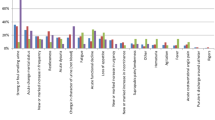Summary
We examined the value of the dipstick test for detecting pyuria and bacteriuria in the diagnosis of urinary tract infection (UTI). The dipstick esterase test could be quickly assessed and could easily detect leukocyte esterase in the urine. This was well correlated with the conventional sedimentation method. The dipstick nitrate reduction method for detecting bacteriuria, however, was not well correlated with the urine culture method. These findings suggested that the dipstick esterase test was a useful method for detecting pyuria in the diagnosis of UTI, but not the dipstick nitrate reduction method. Catheter-associated UTI is the most difficult category of UTI to treat and control. One of the reasons for this is the formation of biofilm around the indwelling catheter. We attempted to evaluate the effect of catheter exchange just before treatment of catheter-associated UTI with either 300 or 600 mg/day of levofloxacin, one of the newer quinolones. However, we are unable to find any apparent effect on the drug's efficacy.
Zusammenfassung
Wir untersuchten den Nutzen des Eintauchteststreifens zur Ermittlung einer Leukozyturie und Bakteriurie für die Diagnosestellung einer Harnwegsinfektion (HWI). Der Esterase-Streifentest läßt sich schnell durchführen; damit kann die Leukozytenesterase sehr leicht im Urin festgestellt werden. Der Nitrit- Streifentest zur Ermittlung einer Bakteriurie korrelierte dagegen sehr schlecht mit den Ergebnissen der Urinkultur. Daraus ergibt sich, daß der Esterase-Teststreifen zur Ermittlung einer Leukozyturie im Gegensatz zum Nitrit-Streifentest bei der Diagnosestellung einer HWI nützlich ist. Katheter-bedingte HWI sind die am schwierigsten zu behandelnden Gruppen von HWI. Einer der Gründe dafür ist die Bildung von Biofilm auf der Katheteroberfläche. Wir untersuchten die Wirksamkeit des Katheterwechsels unmittelbar vor Therapiebeginn einer Katheter-bedingten HWI, wobei zur Therapie 300 oder 600 mg/Tag Levofloxacin, eines der neueren Chinolone, verwendet wurde. Wir konnten jedoch keinen Einfluß dieser Maßnahme auf die Medikamentenwirksamkeit nachweisen.
Similar content being viewed by others
References
Ohkoshi, M. Criteria for evaluation of clinical efficacy of antimicrobial agents on urinary tract infection (Third Ed.). Jap. J. Antibiotics 40 (1987) 2149–2191.
Skjold, A. C., Stover, L., Pendergrass, J., Corey, P., Cattell, J., Burkhardt, A., Farinelli, M., Tyhach, R., Albarell, J., Ward, F., Yip, T. A new dip-and-read test for leukocytes in urine. Clin. Chem. 31 (1985) 993.
Kusumi, R. K., Grover, P. J., Kunin, C. M. Rapid detection of pyuria by leukocyte esterase activity. JAMA 245 (1981) 1653–1655.
Matsumoto, T. Evaluation of drug efficacy for catheterized patients. In:Ohkoshi, M., Kawada, Y. (eds.): Clinical evaluation of drug efficacy in UTI. Elsevier Science Publishers, Amsterdam 1990, pp. 65–77.
Costerton, J. W., Cheng, K. J., Geesey, G. G., Ladd, T. I., Nickel, J. C., Dasgupta, M., Marrie, T. J. Bacterial biofilm in nature and disease. Rev. Microbiol. 41 (1987) 435–464.
Author information
Authors and Affiliations
Rights and permissions
About this article
Cite this article
Kumazawa, J., Matsumoto, T. The dipstick test in the diagnosis of UTI and the effect of pretreatment catheter exchange in catheter-associated UTI. Infection 20 (Suppl 3), S157–S159 (1992). https://doi.org/10.1007/BF01704360
Issue Date:
DOI: https://doi.org/10.1007/BF01704360



